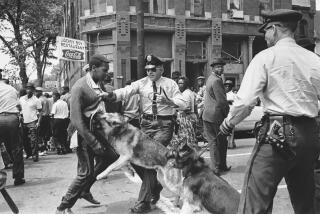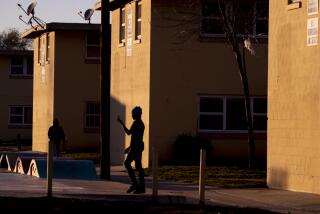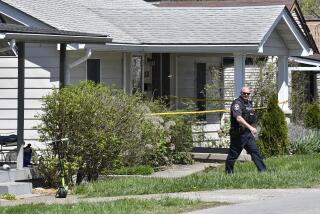Cincinnati Imposes a Curfew After 3 Nights of Racial Violence
CINCINNATI — Following three nights of rioting, looting and gunfire, the mayor here issued a “proclamation of emergency” and imposed a citywide curfew Thursday, but the action appeared only to inflame the racial tensions that erupted when a white police officer shot and killed an unarmed black man.
In a scene reminiscent of 1968, when racial violence swept through this Ohio River city following the assassination of Martin Luther King Jr., Mayor Charles Luken stood before community leaders, police and reporters and declared that Cincinnati has “a very legitimate and real problem with race relations” but said his first priority was restoring the peace.
“The only issue we are focused on today is getting the criminal element off our streets,” Luken said. “Black citizens are tired--they’re scared in their homes. White citizens are tired--they’re targeted in their cars. I think we have to exercise unprecedented, and a week ago unthinkable, measures to protect those citizens and to protect our police officers.”
As evening descended and news of the 8 p.m.-to-6 a.m. curfew spread, however, many African Americans railed against the crackdown and predicted widespread violations.
“They are restricting black folks once again. They’re setting rules on us, but they’re not setting rules on the police force,” said Yvette Hall, 25, at a rally led by Kweisi Mfume, president of the National Assn. for the Advancement of Colored People. “Saturday, when they bury that boy, there’s going to be hell to pay.”
She referred to Timothy Thomas, 19, who was killed after a police chase Saturday. He was the fourth black slain by Cincinnati police since November.
Mfume found himself nearly alone at the rally of 200 in calling for people to respect the curfew and urging them not to break the law even if they don’t agree with it. Many at the gathering outside the New Friendship Baptist Church near downtown said tempers were rising and still had a way to go.
“They’re going to rebel,” warned Pastor Mark Monroe of the Unity Temple Ministry. “The religious community has lost influence. Nothing we said could stop them from doing what they were going to do.”
The curfew will remain in place as long as necessary, city officials said, making it illegal to be on the street unless traveling to or from work. And as the rally broke up--early because of the curfew--police in full riot gear, on foot, horseback and in cruisers, began fanning out across the city to enforce it.
Twenty curfew violators were arrested, but the city was otherwise quiet as midnight approached Thursday. Near the scene of some of the worst disturbances, streets had been cleared of debris and two youngsters jumped rope in front of their home. There was little apparent police presence.
Taxis stopped running, restaurants shut down and the Roman Catholic archdiocese canceled its popular Good Friday midnight service, which typically draws thousands of worshipers, for the first time since the tradition began in 1859. A message on the archdiocese’s answering machine encouraged parishes to cancel Easter sunrise services as well, in case the curfew was still in effect.
The city police were augmented by state troopers sent in by Ohio Gov. Robert A. Taft, and city and state officials left open the possibility of calling in National Guard troops.
Earlier in the day, President Bush phoned Atty. Gen. John Ashcroft to discuss the situation, White House spokesman Ari Fleischer said. Two Justice Department community relations officials were dispatched to Cincinnati and held meetings Thursday with city officials, police officers and black leaders.
The turmoil began Monday, two days after 26-year-old Police Officer Steve Roach shot Thomas at the end of a dark alley after a foot chase.
Thomas had 14 warrants out for his arrest, all for misdemeanors and most for traffic violations. The most serious charge was for allegedly receiving stolen property.
When Roach tried to arrest him late Saturday night in the predominantly black Over-the-Rhine neighborhood, Thomas fled, according to police. As Roach chased him, police say the officer later explained, Thomas turned and appeared to be reaching for a weapon. Roach fired, striking Thomas in the chest. No weapon was found.
Seeking to quiet critics who said police were not being forthcoming about their investigation of the case, the department on Thursday released video taken from a patrol car camera during the pursuit of Thomas. The video--shaky, blurry, dark and taken from a cruiser speeding around a corner--revealed little. The accompanying audio provided one grim detail: a single telltale “pop.”
The police said they have completed their internal investigation into Thomas’s death and turned the case over to Hamilton County Prosecutor Michael Allen, who said he will likely convene a grand jury next week. The FBI, U.S. Justice Department and the U.S. attorney’s office are all conducting civil rights probes.
Since protests erupted into full-blown rioting Monday, 86 people have been arrested for looting, arson, assaults and other violence, mostly in the parts of town where the population is predominantly black. More than 60 people have been injured, including at least 25 taken to hospitals, police said.
Police have played a thus-far nonlethal game of cat and mouse with some of the protesters: Young black men hurl bottles and rocks from behind cars or from rooftops, and police return fire with rubber bullets and shotgun-launched beanbags.
One officer narrowly escaped serious injury Wednesday night when a rioter shot him, but the slug was deflected by his belt buckle, police said. The suspect has not been caught, though police apprehended a man who fit the description of the suspect and, according to some, treated him roughly before letting him go--raising animosities even further.
If racial tensions in the city only burst into the headlines this week, they have been growing for some time in the city of 331,000, which is 46% black. The dispute, most residents seem to agree, is less between blacks and whites than between blacks and the Police Department.
Since 1995, Cincinnati police have killed 15 black suspects. No white suspects were killed.
“Fifteen young black men die . . . and every time we try to get an answer, they say the officer acted as he was supposed to,” said Ishton Morton of the local branch of the NAACP. “All these victims are black. It starts to look suspicious.”
For at least two years, Morton and others have been warning city officials of growing problems between police officers and blacks.
In March, the American Civil Liberties Union of Ohio, along with several other civil rights groups, filed a federal lawsuit accusing the city of a “30-year pattern of racial profiling.” Not only are blacks punished more frequently than whites are for minor offenses, the suit alleges, but police “tend to use excessive and deadly force against African Americans more readily than against whites.”
*
Simon reported from Cincinnati and Slater from Chicago.
More to Read
Sign up for Essential California
The most important California stories and recommendations in your inbox every morning.
You may occasionally receive promotional content from the Los Angeles Times.










